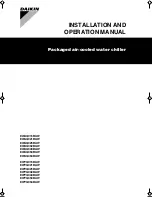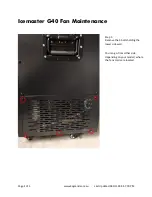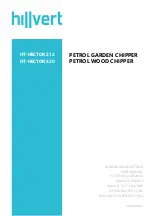
To charge refrigerant into the evaporator, fill clean solu-
tion containers with the distilled or deionized water. Charge
the water through the refrigerant pump service valve, fol-
lowing the appropriate steps in Charging Solution section.
Charge in at least the amount listed in Table 3 under Ini-
tial Refrigerant amount. This charge must be adjusted after
start-up to achieve optimal Cycle-Guard™ control condi-
tions to limit the maximum solution concentration (which
prevents solution crystallization). However, any extra re-
frigerant should be limited because the normal refrigerant
pump discharge pressure is below atmospheric pressure and
a vacuum bottle is required to remove refrigerant (see Final
Refrigerant Charge Adjustment section, page 25).
Table 3 — Nominal Machine Charges*
UNIT
16JT
LiBr SOLUTION
INITIAL REFRIGERANT
Gal
Kg
Gal
Kg
810,812,814
137
840
87
330
816,818,821
200
1225
106
400
824
246
1505
92
350
828
257
1575
92
350
832
309
1890
114
430
836
314
1925
114
430
841
366
2240
137
520
847
400
2450
137
520
854
440
2695
165
625
857
463
2835
165
625
865
514
3150
203
770
873
560
3430
232
880
880
623
3815
285
1080
080
754
4620
177
670
090
846
5180
201
760
100
903
5530
215
815
110
1017
6230
202
765
120
1097
6720
206
780
135
1263
7740
238
900
150
1377
8435
271
1025
080L
823
5040
197
745
090L
922
5650
211
800
100L
1006
6160
225
850
110L
1114
6825
219
830
120L
1200
7350
238
900
135L
1380
8450
277
1050
150L
1504
9210
304
1150
*Based on 55% concentration of solution, 44 F (7 C) leaving chilled water,
85 F (29 C) entering condensing water.
INITIAL CONTROL CHECKOUT
AND ADJUSTMENT
The checkout procedures in this section are for semi-
automatic control systems. The purpose of the checkout is to
ensure that control circuits have not been affected by ship-
ping or installation damage or altered in the process of mak-
ing field wiring connections.
NOTE: Some thermoswitch adjustments are scaled in Cel-
sius, hence that is the temperature stated first in some of the
instructions in this manual.
Follow the checkout sequence in detail. Machine must
be charged with solution and refrigerant before starting
checkout. Chilled water and condensing water circuits
must be filled and operative, but the manual steam or
hot water valve must remain closed.
Do not rotate hermetic pumps until machine is charged
with lithium bromide-water solution and refrigerant.
Preparation
1. Open the control panel and place the main circuit breaker
in OFF position (Fig. 13) to deenergize the control circuit
and pump motor.
2. Disconnect leads for solution pump motor and refriger-
ant pump motor at secondary starter terminals. Wrap the
ends of the disconnected wires with electrical tape and
mark for proper identification at reinstallation.
3. If starters for condensing water pump and chilled water
pump are operated by manual start-stop, temporarily place
an insulated jumper between terminals P1 and P2 to over-
ride the external interlock. Remove fuses from starters
for the condensing water pump motor and chilled water
pump motor. (Starters for these motors are field supplied
on external voltage lines and are not located in control
panel.)
If condensing and chilled water flow switches are used,
manually block the switches closed.
IMPORTANT: Do not open manual steam or hot
water valves.
Energize Control Circuit
1. Place the main circuit breaker in the ON position to en-
ergize control circuit. (Stop light turns red.)
2. Depress the Stop button to clear any safety fault condi-
tions and to prepare the control circuit for starting.
3. Place the control panel settings in the following
positions:
SETTINGS
POSITION
Capacity Control
AUTO.
Cycle Guard Switch
AUTO.
Local/Remote Switch
LOCAL
4. Depress the Start button momentarily to start the ma-
chine. The Run light turns green and the start cycle be-
gins.With normal operation, the solution pump starts im-
mediately and the refrigerant pump starts after about
5 minutes.
Check Solution and Refrigerant Pump
Starters
1. Make sure the solution and refrigerant pump starters are
energized.
2. Depress the Stop button momentarily (Run light de-
energizes). Both starters remain energized for approxi-
mately 15 minutes during dilution cycle (Dilution light
energizes).
Check Pump Starter Overloads
1. Depress the Start button, and wait for the pumps to start.
2. Push the trip bar on the side of the refrigerant pump starter
overload. All pump starters deenergize, the alarm buzzer
sounds, and the fault light identifies the fault category.
3. Depress the Stop button (to silence the alarm) and the
starter reset bar.
4. Repeat Steps 1 - 3 with other control panel starters. Refer
to the wiring diagrams for the set point of each starter.
5. Starters for auxiliary equipment must be similarily checked,
according to the manufacturers’ instructions.
Check Low-Temperature Cutout
1. Turn the differential adjustment screw until differential
set point is at 4 C (7.2 F).
2. Place control sensing bulb in a water bath maintained at
9° F (5° C) below design leaving chilled water tempera-
ture (but not below 36 F [2 C]). This is the correct low-
temperature cutout setting.
3. Depress the Start button.
Slowly turn cutout adjustment knob clockwise until con-
tacts open. Chilled water, condensing water, solution and
refrigerant pump starters, and Run light should de-
energize, the alarm buzzer should sound, and the fault
light should identify the fault category.
22
Summary of Contents for 16JT Series
Page 11: ...Fig 10 Typical Wiring Diagram 11 ...
Page 12: ...Fig 10 Typical Wiring Diagram cont 12 ...
Page 13: ...Fig 11 Typical Control Wiring 13 ...
Page 43: ......
















































